R.J. Stowell's Blog: rjsomeone, page 54
November 15, 2018
The Battle of Evermore - Led Zeppelin
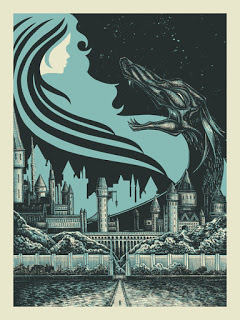 In "The Battle of Evermore" (LZ4), Robert Plant introduces the Queen of Light, who is central to "Stairway To Heaven." Like "Stairway" and so much of Zeppelin's imagery, "Evermore" is influenced by Celtic mythology, particularly the fifteenth and sixteenth century Anglo-Scottish wars. Most Zeppelin enthusiasts know the story of the song's creation — Jimmy Page casually picking up John Paul Jones' mandolin at the band's house-cum-studio, Headley Grange, in East Hampshire. "On 'The Battle of Evermore,' a mandolin was lying around," Page said to Guitar Player in 1977. "It wasn't mine, it was Jonesey's. I just picked it up, got the chords, and it sort of started happening. I did it more or less straight off. But, you see, that's fingerpicking again, going back to the studio days and developing a certain amount of technique – at least enough to be adapted and used. My fingerpicking is a sort of cross between Pete Seeger, Earl Scruggs, and total incompetence." Sound engineer Andy Johns said of the recording: "The band was sitting next to the chimney in Headley, drinking tea, when Jimmy grabbed a mandolin and started playing. I gave him a microphone and stuck a Gibson echo on his mandolin. Jimmy had brought this stuff before and had asked me to take a look at it. Suddenly Robert started singing and this amazing track was born from nowhere." Sandy Denny, the one-time singer for Fairport Convention, a Brit-folk band, was asked to play the Queen of Light's role. whose feminine strength and wisdom grounds the masculine warrior, Plant. She sings of the coming battle and urges on the prince with lines like "Dance in the dark night, sing to the morning light" and "Throw down your plow and hoe, race now to my bow." The archetype re-emerges in "Stairway to Heaven" as the May Queen and some maintain a connection to "Going to California" (itself an homage to Joni Mitchell).
In "The Battle of Evermore" (LZ4), Robert Plant introduces the Queen of Light, who is central to "Stairway To Heaven." Like "Stairway" and so much of Zeppelin's imagery, "Evermore" is influenced by Celtic mythology, particularly the fifteenth and sixteenth century Anglo-Scottish wars. Most Zeppelin enthusiasts know the story of the song's creation — Jimmy Page casually picking up John Paul Jones' mandolin at the band's house-cum-studio, Headley Grange, in East Hampshire. "On 'The Battle of Evermore,' a mandolin was lying around," Page said to Guitar Player in 1977. "It wasn't mine, it was Jonesey's. I just picked it up, got the chords, and it sort of started happening. I did it more or less straight off. But, you see, that's fingerpicking again, going back to the studio days and developing a certain amount of technique – at least enough to be adapted and used. My fingerpicking is a sort of cross between Pete Seeger, Earl Scruggs, and total incompetence." Sound engineer Andy Johns said of the recording: "The band was sitting next to the chimney in Headley, drinking tea, when Jimmy grabbed a mandolin and started playing. I gave him a microphone and stuck a Gibson echo on his mandolin. Jimmy had brought this stuff before and had asked me to take a look at it. Suddenly Robert started singing and this amazing track was born from nowhere." Sandy Denny, the one-time singer for Fairport Convention, a Brit-folk band, was asked to play the Queen of Light's role. whose feminine strength and wisdom grounds the masculine warrior, Plant. She sings of the coming battle and urges on the prince with lines like "Dance in the dark night, sing to the morning light" and "Throw down your plow and hoe, race now to my bow." The archetype re-emerges in "Stairway to Heaven" as the May Queen and some maintain a connection to "Going to California" (itself an homage to Joni Mitchell). 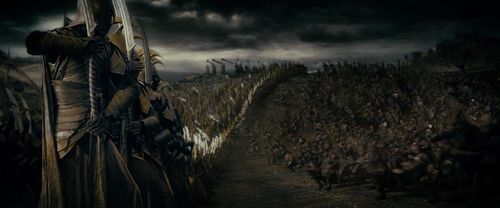 The Battle of PellanorLord of the Rings enthusiasts (Return of the King) see a connection between the Battle of Evermore and the Battle of Pelennor, and for good reason: sources for Tolkien would undoubtedly be similar. "At last the sun is shining,/ The clouds of blue roll by" conjures up Sauron's army as the sky darkened. As Sauron inevitably loses the battle, the light returns. Equal parts don't fit, the Angels of Avalon, for instance, emerge from the legends of Merlin and King Arthur. Interestingly, Avalon is Latin for the Place of Apples, which shows Plant doing his research as he deconstructs the construct: "I'm waiting for the angels of Avalon,/ waiting for the eastern glow. The apples of the valley hold the seeds of happiness." In many ways the song, and in particular the the title, conjure up the human condition, struggle in the face of battle, whether real or emotional, with hope eternal – the tireless ideology of humanity that good will prevail.
The Battle of PellanorLord of the Rings enthusiasts (Return of the King) see a connection between the Battle of Evermore and the Battle of Pelennor, and for good reason: sources for Tolkien would undoubtedly be similar. "At last the sun is shining,/ The clouds of blue roll by" conjures up Sauron's army as the sky darkened. As Sauron inevitably loses the battle, the light returns. Equal parts don't fit, the Angels of Avalon, for instance, emerge from the legends of Merlin and King Arthur. Interestingly, Avalon is Latin for the Place of Apples, which shows Plant doing his research as he deconstructs the construct: "I'm waiting for the angels of Avalon,/ waiting for the eastern glow. The apples of the valley hold the seeds of happiness." In many ways the song, and in particular the the title, conjure up the human condition, struggle in the face of battle, whether real or emotional, with hope eternal – the tireless ideology of humanity that good will prevail. The cryptic ideology continues throughout the LP, and indeed in the cover itself. The symbols, or runes, on Led Zeppelin IV represent each member of the band, as well as Sandy Denny. Page decided that the next Led Zeppelin album would not have a title, but would instead feature four hand-drawn symbols. "We decided that on the fourth album, we would deliberately play down the group name, and there wouldn’t be any information whatsoever on the outer jacket. After all this crap that we'd had with the critics, I put it to everybody else that it'd be a good idea to put out something totally anonymous."
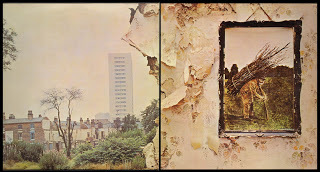 Zoso, Page's symbol represents Saturn, which rules over Page's astrological sun sign, Capricorn. John Paul Jones' symbol, which he chose from Rudolph Koch's Book of Signs, is a single circle intersecting the Vesica Pisces (a triquetra, Cherubim found on the Ark of the Covenent) and represents a person who possesses both confidence and competence. John Bonham's three interlocking rings, picked by the drummer from the same book, represents the trinity of mother, father and child. Plant’s symbol is the feather of Ma'at, the Egyptian goddess of justice and fairness, and is the emblem of a writer. The fifth, smaller symbol, three intersecting, inverted pyramids (the Godhead), was chosen by guest vocalist Sandy Denny and appears in the credits on the inner sleeve.
Zoso, Page's symbol represents Saturn, which rules over Page's astrological sun sign, Capricorn. John Paul Jones' symbol, which he chose from Rudolph Koch's Book of Signs, is a single circle intersecting the Vesica Pisces (a triquetra, Cherubim found on the Ark of the Covenent) and represents a person who possesses both confidence and competence. John Bonham's three interlocking rings, picked by the drummer from the same book, represents the trinity of mother, father and child. Plant’s symbol is the feather of Ma'at, the Egyptian goddess of justice and fairness, and is the emblem of a writer. The fifth, smaller symbol, three intersecting, inverted pyramids (the Godhead), was chosen by guest vocalist Sandy Denny and appears in the credits on the inner sleeve. Narrator: The Queen of Light took her bow and then she turned to goThe Prince of Peace embraced the gloom and walked the night aloneQueen of Light: Oh, dance in the dark night, sing to the morning lightNarrator: The Dark Lord rides in force tonight, and time will tell us allQueen of Light: Oh, throw down your plow and hoe, race now to my bowNarrator: Side by side we wait the might, of the darkest of them all
I hear the horses thunder down in the valley belowI’m waiting for the angels of Avalon, waiting for the eastern glowThe apples of the valley hold the seeds of happinessThe ground is rich from tender care, which they do not forget, no, no
Queen of Light: Dance in the dark night, sing to the morning lightNarrator: The apples turn to brown and black, the tyrant’s face is redQueen of Light: Oh, war is the common cry, pick up your swords and flyNarrator: The sky is filled with good and bad, mortals never know
Oh well, the night is long, the beads of time pass slowTired eyes on the sunrise, waiting for the eastern glow
Narrator: The pain of war cannot exceed the woe of aftermathThe drums will shake the castle wall, the Ringwraiths ride in black, ride onQueen of Light: Sing as you raise your bow, shoot straighter than beforeNarrator: No comfort has the fire at night that lights the face so coldQueen of Light: Oh, dance in the dark night, sing to the morning lightNarrator: The magic runes are writ in gold to bring the balance back, bring it back
At last the sun is shining, the clouds of blue roll byWith flames from the dragon of darkness, the sunlight blinds his eyes
Published on November 15, 2018 04:54
November 14, 2018
Led Zeppelin IV - ZOSO
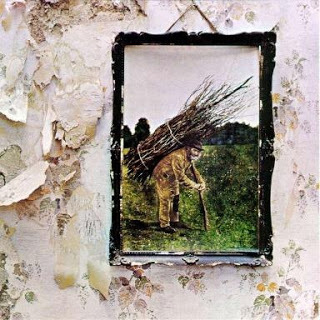 Led Zeppelin VI (AM10) encompasses all that we've come to associate with heavy metal in the 1970s; strong rhythm and distortion, guitar solos and machismo. Brash opener "Black Dog" and "Rock and Roll," which follows, reiterate that straight away. Yet, what makes this record so appealing is that it stretches beyond Zeppelin's previous soirees in genre and dimension. Led Zeppelin IV is a metal record mixed into a concoction that contains the blues and a bit of rock and roll, with old-English folk and the occult mixed in for good measure; brilliantly, though subtlety comprised, it all falls perfectly into place.
Led Zeppelin VI (AM10) encompasses all that we've come to associate with heavy metal in the 1970s; strong rhythm and distortion, guitar solos and machismo. Brash opener "Black Dog" and "Rock and Roll," which follows, reiterate that straight away. Yet, what makes this record so appealing is that it stretches beyond Zeppelin's previous soirees in genre and dimension. Led Zeppelin IV is a metal record mixed into a concoction that contains the blues and a bit of rock and roll, with old-English folk and the occult mixed in for good measure; brilliantly, though subtlety comprised, it all falls perfectly into place. Robert Plant's dynamic vocals are best utilized during the folklore-ish, "The Battle of Evermore" and in the urgency of "Four Sticks," both of which are pivotal moments on the record. The anthemic "Stairway to Heaven" sits perfectly between the two. An angelic and heart-stopping arrangement, this seminal number, defined by Page's double neck guitar, is a poetic composition of epic proportion. This and its longevity are perhaps enough when in contention for "Best Album Ever," and although it's not my choice (it’s not even my fave Zeppelin LP), I won't argue with anyone who feels it is.
 One of the ways in which the album's dominance is demonstrated is the sheer variety: out of the eight cuts, there isn't one that steps on another's toes. There are the aforementioned Olde English ballads ("The Ballad of Evermore" with a lovely performance by Sandy Denny), a kind of pseudo-blues just to keep in touch ("Four Sticks"), a pair of authentic Zepplinania ("Black Dog" and "Misty Mountain Hop"), some stuff that I might actually call shy and poetic if it didn't carry itself off so well ("Stairway to Heaven" and "Going To California"), and a couple songs that when all is said and done, will probably be right up there in the gold-starred hierarchy of put 'em on and play 'em agains. The end of the LP serves up "When The Levee Breaks," strangely credited to all the members of the band plus Memphis Minnie, and it's a dazzler. Basing themselves around one honey of a chord progression, the band constructs an air of tunnel-long depth, full of stunning resolves and a majesty that sets up the perfect climax (see note below). It's forty years since IV; it's been a long time since I rock 'n' rolled over dead – not like this. It's been a long, lonely, lonely, lonely, lonely, lonely time.
One of the ways in which the album's dominance is demonstrated is the sheer variety: out of the eight cuts, there isn't one that steps on another's toes. There are the aforementioned Olde English ballads ("The Ballad of Evermore" with a lovely performance by Sandy Denny), a kind of pseudo-blues just to keep in touch ("Four Sticks"), a pair of authentic Zepplinania ("Black Dog" and "Misty Mountain Hop"), some stuff that I might actually call shy and poetic if it didn't carry itself off so well ("Stairway to Heaven" and "Going To California"), and a couple songs that when all is said and done, will probably be right up there in the gold-starred hierarchy of put 'em on and play 'em agains. The end of the LP serves up "When The Levee Breaks," strangely credited to all the members of the band plus Memphis Minnie, and it's a dazzler. Basing themselves around one honey of a chord progression, the band constructs an air of tunnel-long depth, full of stunning resolves and a majesty that sets up the perfect climax (see note below). It's forty years since IV; it's been a long time since I rock 'n' rolled over dead – not like this. It's been a long, lonely, lonely, lonely, lonely, lonely time.Mike Damone's Five Point Plan (Fast Times at Ridgemont High):
First of all Rat, you never let on how much you like a girl. "Oh, Debbie. Hi." Two, you always call the shots. "Kiss me. You won't regret it." Now three, act like wherever you are, that's the place to be. "Isn't this great?" Four, when ordering food, you find out what she wants, then order for the both of you. It's a classy move. "Now, the lady will have the linguine and white clam sauce, and a Coke with no ice." And five, now this is the most important, Rat. When it comes down to making out, whenever possible, put on side one of Led Zeppelin IV.

Published on November 14, 2018 05:10
November 13, 2018
Led Zeppelin III
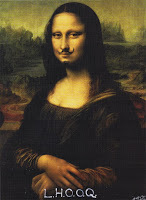 Modern culture has ripped the Mona Lisa right out of us; her image so ingrained in our collective psyche that we barely stop to even look. In the 1919 Marcel DuChamp recreated the Mona Lisa with a moustache and the caption "L.H.O.O.Q." which when pronounced phonetically (in French, of course) translates as, "She's got a hot ass." It was his way of making us look again. Often ignored in favor of the second and fourth albums, LZIII (AM7) is an unrecognized jewel. Zep fans who don't migrate here when ZOSO is just one listen away from intolerable, when "Stairway" is as timeworn as La Gioconda, have missed out on their fave band's most accessible LP. III is the Mona Lisa with a hot ass.
Modern culture has ripped the Mona Lisa right out of us; her image so ingrained in our collective psyche that we barely stop to even look. In the 1919 Marcel DuChamp recreated the Mona Lisa with a moustache and the caption "L.H.O.O.Q." which when pronounced phonetically (in French, of course) translates as, "She's got a hot ass." It was his way of making us look again. Often ignored in favor of the second and fourth albums, LZIII (AM7) is an unrecognized jewel. Zep fans who don't migrate here when ZOSO is just one listen away from intolerable, when "Stairway" is as timeworn as La Gioconda, have missed out on their fave band's most accessible LP. III is the Mona Lisa with a hot ass.Riff rock along the lines of "Immigrant Song", "Celebration Day" and "Out on the Tiles" is in check, but the word of the day is subtlety. "Friends," "Tangerine" and "That's the Way" are acoustic highlights, celebrating English folk, nonstandard guitar tunings and a general adoration for the rustic life. If you've never heard this one, you owe it to yourself to pick it up and discover a whole different side of Led Zeppelin. This one's not there to rock you senseless.

Pretty ironic that fans and critics in 1971 were so mortified by Zep's turn toward the Dark Side (i.e. the scandalous use of, gulp, acoustic instrumentation). After all, the true roots music for an English musician isn't the harmonicas and dobros of the Mississippi Delta, it comes from the lutes and dulcimers of traditional English folk. In that context, Led Zeppelin III is as close as the band ever got to putting out an "English Soul" LP. "Gallows Pole" is the best example of traditional folk of the Zeppelin ilk. How many other hard rocking numbers can you name that feature banjo, for God's sake? III is arguably Zeppelin's most consistently listenable album, if only because the songs haven't been ruined by incessant FM airplay over the years.
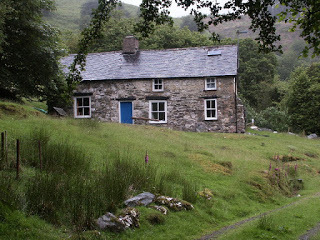 Led Zeppelin III was part a response to critics who called the band one-sided and over the top and part a product of Jimmy Paige's and Robert Plant's love of "music for hippie bookstores" such as American songwriters like Joni Mitchell and Love's Arthur Lee or Brit folk bands like Fairport Convention and Steeleye Span. After nearly two years of constant touring, the band retreated to the cottage where Robert Plant summered with his family when young. According to music journalist Jonathan Wingate, Led Zeppelin III's "folky" feel could only have been created somewhere like Bron Yr Aur (pron. bron-rar): "After Led Zeppelin I and II, the fans were expecting another beefy album driven by heavy guitar riffs. But without any electricity to power big amplifiers, what they actually came up with was something which sounded much more acoustic and pastoral," he said. "When you listen to it you just have to close your eyes and you can hear the echoes of this remote country house. It's an album which you can imagine being performed around a crate of beer in front of a roaring log fire." Yeah, I'm going to try that. Led Zeppelin III is like finding a long forgotten LP among the stacks and never before realizing its power and subtlety.
Led Zeppelin III was part a response to critics who called the band one-sided and over the top and part a product of Jimmy Paige's and Robert Plant's love of "music for hippie bookstores" such as American songwriters like Joni Mitchell and Love's Arthur Lee or Brit folk bands like Fairport Convention and Steeleye Span. After nearly two years of constant touring, the band retreated to the cottage where Robert Plant summered with his family when young. According to music journalist Jonathan Wingate, Led Zeppelin III's "folky" feel could only have been created somewhere like Bron Yr Aur (pron. bron-rar): "After Led Zeppelin I and II, the fans were expecting another beefy album driven by heavy guitar riffs. But without any electricity to power big amplifiers, what they actually came up with was something which sounded much more acoustic and pastoral," he said. "When you listen to it you just have to close your eyes and you can hear the echoes of this remote country house. It's an album which you can imagine being performed around a crate of beer in front of a roaring log fire." Yeah, I'm going to try that. Led Zeppelin III is like finding a long forgotten LP among the stacks and never before realizing its power and subtlety.
Published on November 13, 2018 04:28
November 12, 2018
Led Zeppelin and the Critics
 AM's conceptual goal was to analyze music utilizing a 10 point rubric, though the site is more the celebration of rock music throughout time. Artists like Gary Clark Jr., Jack White, Andrew McMahon in the Wilderness or Fleet Foxes are proof that rock and pop are as good as ever (written with only a little trepidation). We've got our pet peeves (any song with the artist tag "feat." and I throw up a little in my mouth), but find discussions of such ephemeral, and focus on what's essential. Snap judgments don't fit into the rubric; we'll leave that to Lester Bangs.
AM's conceptual goal was to analyze music utilizing a 10 point rubric, though the site is more the celebration of rock music throughout time. Artists like Gary Clark Jr., Jack White, Andrew McMahon in the Wilderness or Fleet Foxes are proof that rock and pop are as good as ever (written with only a little trepidation). We've got our pet peeves (any song with the artist tag "feat." and I throw up a little in my mouth), but find discussions of such ephemeral, and focus on what's essential. Snap judgments don't fit into the rubric; we'll leave that to Lester Bangs. Bangs, for instance, said of Led Zeppelin's eponymous first LP that "'Babe I'm Gonna Leave You'" alternates between prissy Robert Plant's howled vocals fronting an acoustic guitar and driving choruses of the band running down a four-chord progression while John Bonham smashes his cymbals on every beat. The song is very dull in places (especially on the vocal passages), very redundant, and certainly not worth the six-and-a-half minutes the Zeppelin gives it." Seriously? It's 1969. No one has even touched upon what "the Zeppelin" was doing, and it's not just 20/20 hindsight that recognizes this. Critics love to be contrarians and naysayers and critics of AM say we "lack the critical eye, kowtowing to the self-evident." So be it; call me Catherine Obvious. In Woody Allen's Manhattan, Diane Keaton trashes, among others, Gustav Mahler, Ingmar Bergman and Van Gogh, taking a typically contrarian rhetorical approach by mispronouncing their names (that'll show them). Allen's response is that "all those people are great," a simplistic retort that merely shows the exasperation of those who appreciate for those who don't.
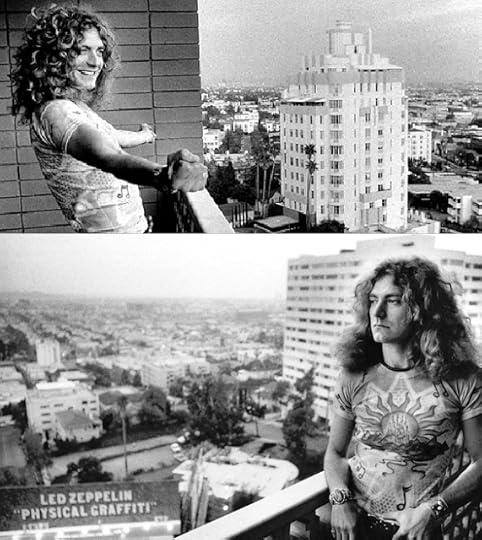
But back to Bangs, who reports that, "The album's most representative cut is "How Many More Times." Here a jazzy introduction gives way to a driving (albeit monotonous) guitar-dominated background for Plant's strained and unconvincing shouting (he may be as foppish as Rod Stewart, but he's nowhere near so exciting, especially in the higher registers)." Now, I have a spot in my heart reserved for "Maggie Mae" as the song playing the first time I put my hand up a girl's sweater, but Plant not nearly as exciting as Rod Stewart? Comical.
Bangs' go to band was always Cream as the harbinger of all things great in music, and his review for LZ1 concludes by beating the dead Cream horse with, "It would seem that, if they're to help fill the void created by the demise of Cream, they will have to find a producer (and editor) and some material worthy of their collective attention." (We won't mention the ill-conceived grammar or the passive voice.) LZ1 is an AM8 and rising, and seemingly only Lester Banks felt otherwise. I'll take the AM premise any day.
While Rolling Stone was getting everything wrong, Tony Palmer, in London's The Guardian got it right, knowing in 1969 what the rest of us know nearly 50 years later. As a part of our focus on Led Zeppelin, here's a portion of Palmer's article:
On the west coast of America, in San Francisco, there is a famous concert hall called the Fillmore Auditorium. It's run by a wisecracking, loud-mouthed magician called Bill Graham. To be invited to play there is like receiving the gold medal from the Philharmonic Society – you've arrived.
Whether by accident or design, Graham has succeeded in launching most of the international pop groups whose claim to fame is musical rather than fashionable. Cream, Jimi Hendrix and the Who all owe a great deal to his fanatical championship. And at the beginning of January, he promoted a new group called, rather enigmatically, Led Zeppelin. If their LP is anything to go by, he has discovered a worthy successor to the defunct Cream. For their first LP, the group had advance orders for 50,000 copies in California alone; wherever they played, they got standing ovations.
They're all in their 20s and extravagantly hirsute in the current manner. They started as a group in November last year and the LP now released is the product of their first improvisations together. They rely on formalized beginnings and endings and leave the rest to the mood of the moment, and they are complete masters of their material. They bend and twist the simplest of lines into architectural caverns of sound, careful but throbbing with violence. Their music crouches like a giant panther and shudders like a mighty jet waiting to leap down the runway.
Published on November 12, 2018 05:22
November 11, 2018
Led Zeppelin
During September 1968, The New Yardbirds, Jimmy Page, John Bonham, John Paul Jones and Robert Plant, toured Scandinavia performing Yardbirds material as well as new material like "Communication Breakdown," "I Can't Quit You Baby," "You Shook Me," "Babe I'm Gonna Leave You," and "How Many More Times." That same month, at Keith Moon's mocking, The New Yardbirds were renamed Led Zeppelin, and on October 15, 1968, Led Zeppelin made their debut at Surrey University. Soon after, the group began touring the U.S., backing up headliners like Vanilla Fudge and The MC5. Nearly instantaneous recognition followed. On January 31, 1969, Led Zeppelin opened for Iron Butterfly, who, due to "In a Gadda Da Vida," were one of the hottest bands in the world. Led Zeppelin received such resounding approval from the audience that Doug Ingle, lead singer for the Butterfly scrapped the remainder of the tour. Led Zeppelin had become headliners in their own right.
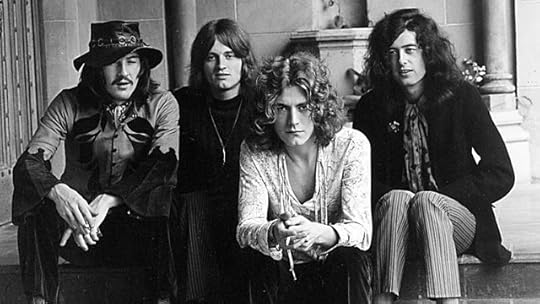
Within eight months of their official debut, Zeppelin was at the top of the bill at the Playhouse Theater in London, and the Pop Proms at the Royal Albert Hall. On October 17, 1969, a year after the band's inception, Zeppelin played Carnegie Hall, ending a ban on rock groups caused by the Rolling Stones' antics in 1965.
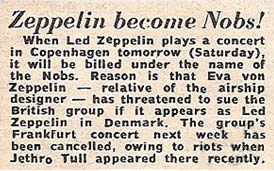 While playing in Denmark, Eva von Zeppelin, relative of the designer of the airship, Ferdinand von Zeppelin, threatened to sue the band if they used the name for their gig in Copenhagan. For that one show, Led Zeppelin played under the alias, The Nobs.
While playing in Denmark, Eva von Zeppelin, relative of the designer of the airship, Ferdinand von Zeppelin, threatened to sue the band if they used the name for their gig in Copenhagan. For that one show, Led Zeppelin played under the alias, The Nobs.
The first LP took but 36 hours of studio time, including mixing and mastering, and was fit into the bands hectic touring schedule. The band was without a label and on the clock to the tune of £1,782, or roughly $3,500. Released January 12, 1969 in the U.S., Led Zeppelin climbed to No. 10 in the U.S. and to No. 6 in the U.K. (Released March 28th). Until the late 60s, producers placed microphones directly in front of the amplifiers and drums. For Led Zeppelin, Page placed an additional microphone some distance from the amplifier (as far as twenty feet) and then recorded the balance between the two. By adopting this "distance equals depth" technique, Page was among the first producers to record a band's "ambient sound;" the distance of a note's time-lag from one end of the room to the other. Led Zeppelin was the first album to be released in stereo-only form; at the time, the practice of releasing both mono and stereo versions was the norm. The LP was the virtual Sgt. Pepper of Heavy Metal Blues.
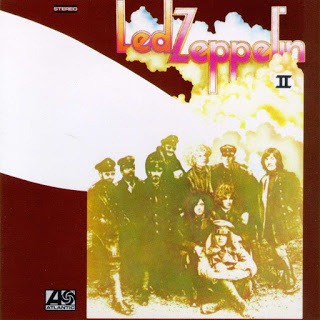 Somehow, this band of misfits broke down the walls of critics (who abhorred the first LP) going straight for the audience, and won with their interpolation of blues, garage rock, soul, shuffle, psychedelic vibes and violin-bowed guitar fer chrissakes; they were over-the-top and minimalist, often in the same song. With tracks about hobbits, mythology and sex in equal form, Led Zeppelin made it look easy.
Somehow, this band of misfits broke down the walls of critics (who abhorred the first LP) going straight for the audience, and won with their interpolation of blues, garage rock, soul, shuffle, psychedelic vibes and violin-bowed guitar fer chrissakes; they were over-the-top and minimalist, often in the same song. With tracks about hobbits, mythology and sex in equal form, Led Zeppelin made it look easy.
Led Zeppelin's debut album (AM8) is a monster of barely contained monolithic intensity (yeah pompous as shit). The album's artistic success hinges on the tension between the reflective/creative/experimental natures of Jimmy Page and John Paul Jones rubbing elbows with the bombastic/flamboyant/amped-up traditionalism of Robert Plant and John Bonham. When these tensions interact fireworks ensue. These are basic musical forms, blues, folk and bluegrass, taken to new extremes of sonic density and timbrel heaviness. Here was a conscious move to unearth the swamp blues from which all rock and roll originated and, at the same time, revitalize the format for a contemporary audience. The likes of The Yardbirds, The Small Faces, John Mayall's Bluesbreakers and Joe Cocker fronted a movement that occasionally bruised the singles chart, but was primarily an underground faction. Hendrix, Beck and Cream pushed this to another, darker dimension and Zeppelin's debut was an integral player in the cadre that opened the floodgates to a bevy of progressive bands whose growing obsession with self-indulgent, sprawling epics lead to an inevitable implosion and the backlash that was punk. That's a lot of rock history in one breath: Led Zeppelinwas the catalyst for it all. By year's end, the band released Led Zeppelin II (Led Zeppelin II, quickly moved up to No. 1 in both the U.S. and the U.K., remaining on the charts for 98 weeks in the States and an astounding 138 weeks in Britain.)
 Late in '69 we'd just moved to a new apartment in North Hollywood. There was no furniture in the living room, bar the white Mediterranean style console stereo. My mother was putting up new curtains and my brother put on Zeppelin II. The acoustic effects (because of the empty room) were amazing, and the transfer of sound from one speaker to the other intensified my fascination. My mother yelled, "Turn that down." There may have been the insertion of an expletive. Nothing seals one's affinity for a rock LP like the criticism of a parent. Just eight years old at the time, I was sold.
Late in '69 we'd just moved to a new apartment in North Hollywood. There was no furniture in the living room, bar the white Mediterranean style console stereo. My mother was putting up new curtains and my brother put on Zeppelin II. The acoustic effects (because of the empty room) were amazing, and the transfer of sound from one speaker to the other intensified my fascination. My mother yelled, "Turn that down." There may have been the insertion of an expletive. Nothing seals one's affinity for a rock LP like the criticism of a parent. Just eight years old at the time, I was sold.
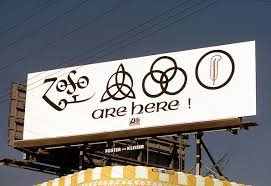 Want to know what hard rock is? Led Zeppelin II (AM8), no bones about it. Zep II delivers in spades with bountiful and bludgeoning force, sex-hot passion, and intricate grace. "Whole Lotta Love" immediately seduces with Page's strutting chops, driving drums and Plant's mile-high wails before hurtling the listener into a sparse and shaky atmosphere of twitching percussion and mind bending guitar squeals. And that's just the first track. Just try to sit still through "The Lemon Song," absorb the beautifully understated "Thank You" and don't forget the Bonham showcase "Moby Dick." This album exhibits a handful of the most influential songs in rock history with blues-soaked attitude to spare, indulgences in instrumentation that have yet to be surpassed, and compositions designed to rock your ass. Zep II is why the boys had their own private jet.
Want to know what hard rock is? Led Zeppelin II (AM8), no bones about it. Zep II delivers in spades with bountiful and bludgeoning force, sex-hot passion, and intricate grace. "Whole Lotta Love" immediately seduces with Page's strutting chops, driving drums and Plant's mile-high wails before hurtling the listener into a sparse and shaky atmosphere of twitching percussion and mind bending guitar squeals. And that's just the first track. Just try to sit still through "The Lemon Song," absorb the beautifully understated "Thank You" and don't forget the Bonham showcase "Moby Dick." This album exhibits a handful of the most influential songs in rock history with blues-soaked attitude to spare, indulgences in instrumentation that have yet to be surpassed, and compositions designed to rock your ass. Zep II is why the boys had their own private jet.

Within eight months of their official debut, Zeppelin was at the top of the bill at the Playhouse Theater in London, and the Pop Proms at the Royal Albert Hall. On October 17, 1969, a year after the band's inception, Zeppelin played Carnegie Hall, ending a ban on rock groups caused by the Rolling Stones' antics in 1965.
 While playing in Denmark, Eva von Zeppelin, relative of the designer of the airship, Ferdinand von Zeppelin, threatened to sue the band if they used the name for their gig in Copenhagan. For that one show, Led Zeppelin played under the alias, The Nobs.
While playing in Denmark, Eva von Zeppelin, relative of the designer of the airship, Ferdinand von Zeppelin, threatened to sue the band if they used the name for their gig in Copenhagan. For that one show, Led Zeppelin played under the alias, The Nobs.The first LP took but 36 hours of studio time, including mixing and mastering, and was fit into the bands hectic touring schedule. The band was without a label and on the clock to the tune of £1,782, or roughly $3,500. Released January 12, 1969 in the U.S., Led Zeppelin climbed to No. 10 in the U.S. and to No. 6 in the U.K. (Released March 28th). Until the late 60s, producers placed microphones directly in front of the amplifiers and drums. For Led Zeppelin, Page placed an additional microphone some distance from the amplifier (as far as twenty feet) and then recorded the balance between the two. By adopting this "distance equals depth" technique, Page was among the first producers to record a band's "ambient sound;" the distance of a note's time-lag from one end of the room to the other. Led Zeppelin was the first album to be released in stereo-only form; at the time, the practice of releasing both mono and stereo versions was the norm. The LP was the virtual Sgt. Pepper of Heavy Metal Blues.
 Somehow, this band of misfits broke down the walls of critics (who abhorred the first LP) going straight for the audience, and won with their interpolation of blues, garage rock, soul, shuffle, psychedelic vibes and violin-bowed guitar fer chrissakes; they were over-the-top and minimalist, often in the same song. With tracks about hobbits, mythology and sex in equal form, Led Zeppelin made it look easy.
Somehow, this band of misfits broke down the walls of critics (who abhorred the first LP) going straight for the audience, and won with their interpolation of blues, garage rock, soul, shuffle, psychedelic vibes and violin-bowed guitar fer chrissakes; they were over-the-top and minimalist, often in the same song. With tracks about hobbits, mythology and sex in equal form, Led Zeppelin made it look easy.Led Zeppelin's debut album (AM8) is a monster of barely contained monolithic intensity (yeah pompous as shit). The album's artistic success hinges on the tension between the reflective/creative/experimental natures of Jimmy Page and John Paul Jones rubbing elbows with the bombastic/flamboyant/amped-up traditionalism of Robert Plant and John Bonham. When these tensions interact fireworks ensue. These are basic musical forms, blues, folk and bluegrass, taken to new extremes of sonic density and timbrel heaviness. Here was a conscious move to unearth the swamp blues from which all rock and roll originated and, at the same time, revitalize the format for a contemporary audience. The likes of The Yardbirds, The Small Faces, John Mayall's Bluesbreakers and Joe Cocker fronted a movement that occasionally bruised the singles chart, but was primarily an underground faction. Hendrix, Beck and Cream pushed this to another, darker dimension and Zeppelin's debut was an integral player in the cadre that opened the floodgates to a bevy of progressive bands whose growing obsession with self-indulgent, sprawling epics lead to an inevitable implosion and the backlash that was punk. That's a lot of rock history in one breath: Led Zeppelinwas the catalyst for it all. By year's end, the band released Led Zeppelin II (Led Zeppelin II, quickly moved up to No. 1 in both the U.S. and the U.K., remaining on the charts for 98 weeks in the States and an astounding 138 weeks in Britain.)
 Late in '69 we'd just moved to a new apartment in North Hollywood. There was no furniture in the living room, bar the white Mediterranean style console stereo. My mother was putting up new curtains and my brother put on Zeppelin II. The acoustic effects (because of the empty room) were amazing, and the transfer of sound from one speaker to the other intensified my fascination. My mother yelled, "Turn that down." There may have been the insertion of an expletive. Nothing seals one's affinity for a rock LP like the criticism of a parent. Just eight years old at the time, I was sold.
Late in '69 we'd just moved to a new apartment in North Hollywood. There was no furniture in the living room, bar the white Mediterranean style console stereo. My mother was putting up new curtains and my brother put on Zeppelin II. The acoustic effects (because of the empty room) were amazing, and the transfer of sound from one speaker to the other intensified my fascination. My mother yelled, "Turn that down." There may have been the insertion of an expletive. Nothing seals one's affinity for a rock LP like the criticism of a parent. Just eight years old at the time, I was sold. Want to know what hard rock is? Led Zeppelin II (AM8), no bones about it. Zep II delivers in spades with bountiful and bludgeoning force, sex-hot passion, and intricate grace. "Whole Lotta Love" immediately seduces with Page's strutting chops, driving drums and Plant's mile-high wails before hurtling the listener into a sparse and shaky atmosphere of twitching percussion and mind bending guitar squeals. And that's just the first track. Just try to sit still through "The Lemon Song," absorb the beautifully understated "Thank You" and don't forget the Bonham showcase "Moby Dick." This album exhibits a handful of the most influential songs in rock history with blues-soaked attitude to spare, indulgences in instrumentation that have yet to be surpassed, and compositions designed to rock your ass. Zep II is why the boys had their own private jet.
Want to know what hard rock is? Led Zeppelin II (AM8), no bones about it. Zep II delivers in spades with bountiful and bludgeoning force, sex-hot passion, and intricate grace. "Whole Lotta Love" immediately seduces with Page's strutting chops, driving drums and Plant's mile-high wails before hurtling the listener into a sparse and shaky atmosphere of twitching percussion and mind bending guitar squeals. And that's just the first track. Just try to sit still through "The Lemon Song," absorb the beautifully understated "Thank You" and don't forget the Bonham showcase "Moby Dick." This album exhibits a handful of the most influential songs in rock history with blues-soaked attitude to spare, indulgences in instrumentation that have yet to be surpassed, and compositions designed to rock your ass. Zep II is why the boys had their own private jet.
Published on November 11, 2018 05:01
November 10, 2018
The Yardbirds Take Off Like a Lead Zeppelin - 1968
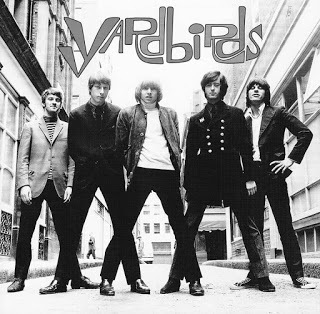 In 1964, the Yardbirds succeeded The Rolling Stones as the house band at the Crawdaddy Club, 1 Kew Road, in Richmond, Surray (It was there, in February 1963 when The Rolling Stones, with all six original members, played their first gig). The Yardbirds were: Eric Clapton, Chris Dreja (rhythm guitar), Jim McCarty (drums), Keith Relf (vocals, harmonica) and Paul Samwell Smith (bass). Clapton would leave in 1965 (following the release of “For Your Love”) to be replaced by Jeff Beck. This iteration of the band would have hits in "Over Under Sideways Down" and "Heartful of Soul" both major breaks into the U.S. market, the latter penned by future 10cc member, Graham Gouldman. Although it didn’t chart in America, "Shapes of Things" would show its might among rising songwriters, including Paul McCartney and Jimi Hendrix, in years to come (David Bowie would cover the track in 1973's Pin Ups). In the year to follow, The Yardbirds, with Beck, would tour extensively, both in the U.K and in America.
In 1964, the Yardbirds succeeded The Rolling Stones as the house band at the Crawdaddy Club, 1 Kew Road, in Richmond, Surray (It was there, in February 1963 when The Rolling Stones, with all six original members, played their first gig). The Yardbirds were: Eric Clapton, Chris Dreja (rhythm guitar), Jim McCarty (drums), Keith Relf (vocals, harmonica) and Paul Samwell Smith (bass). Clapton would leave in 1965 (following the release of “For Your Love”) to be replaced by Jeff Beck. This iteration of the band would have hits in "Over Under Sideways Down" and "Heartful of Soul" both major breaks into the U.S. market, the latter penned by future 10cc member, Graham Gouldman. Although it didn’t chart in America, "Shapes of Things" would show its might among rising songwriters, including Paul McCartney and Jimi Hendrix, in years to come (David Bowie would cover the track in 1973's Pin Ups). In the year to follow, The Yardbirds, with Beck, would tour extensively, both in the U.K and in America.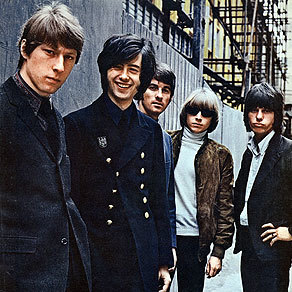 In 1966, Paul Samwell-Smith, the Yardbirds' bassist, decided to leave the group to work as a producer. Jimmy Page was already a well-established studio session man, having played on The Kinks' "I’m a Lover Not a Fighter," The Who's "I Can’t Explain," The Rolling Stones' "Heart of Stone," Them's "Baby Please Don’t Go" and Petula Clark’s "Downtown." Page agreed to play bass in The Yardbirds until rhythm guitarist Chris Dreja transitioned to that instrument. Jeff Beck and Jimmy Page can be heard together on a number of Yardbirds tracks. The most notable is psychedelic classic, "Happenings Ten Years Time Ago" – not only because it features both Page and Beck on lead, but because session bassist John Paul Jones was brought in to play in Page's stead. In addition, for Michelangelo Antonioni’s film noir, Blowup, The Yardbirds, with double leads by Page and Beck, performed "Stroll On," an electric rendition of "Train Keeps a Rollin." Aside from a TV spot for a milkshake product called "Great Shakes," there is only one other Beck/Page track, with John Paul Jones on bass, Keith Moon on drums and Nicky Hopkins on piano—"Beck's Bolero," a piece inspired by Ravel's "Bolero", credited to Page (Beck also claims to have written the song). "Beck's Bolero" was first released as the B-side of Beck's first solo single, "Hi Ho Silver Lining" and was included on Truth.
In 1966, Paul Samwell-Smith, the Yardbirds' bassist, decided to leave the group to work as a producer. Jimmy Page was already a well-established studio session man, having played on The Kinks' "I’m a Lover Not a Fighter," The Who's "I Can’t Explain," The Rolling Stones' "Heart of Stone," Them's "Baby Please Don’t Go" and Petula Clark’s "Downtown." Page agreed to play bass in The Yardbirds until rhythm guitarist Chris Dreja transitioned to that instrument. Jeff Beck and Jimmy Page can be heard together on a number of Yardbirds tracks. The most notable is psychedelic classic, "Happenings Ten Years Time Ago" – not only because it features both Page and Beck on lead, but because session bassist John Paul Jones was brought in to play in Page's stead. In addition, for Michelangelo Antonioni’s film noir, Blowup, The Yardbirds, with double leads by Page and Beck, performed "Stroll On," an electric rendition of "Train Keeps a Rollin." Aside from a TV spot for a milkshake product called "Great Shakes," there is only one other Beck/Page track, with John Paul Jones on bass, Keith Moon on drums and Nicky Hopkins on piano—"Beck's Bolero," a piece inspired by Ravel's "Bolero", credited to Page (Beck also claims to have written the song). "Beck's Bolero" was first released as the B-side of Beck's first solo single, "Hi Ho Silver Lining" and was included on Truth.Beck would leave the band (or was fired from the band) in October 1966 leaving Page the sole lead guitar. The band’s early success as a singles band was never repeated and The Yardbirds would spend the remainder of their time together as a heavier, more experimental unit, rarely playing the hits. One such tune was folk singer, Jake Holmes' "Dazed and Confused." Whether intended or not, Page was grooming himself for his next step. The band would stay together until July 1968 when Rolling Stone announced that Page intended to "go solo." Relf and McCarty would leave the band shortly thereafter to ultimately form Renaissance.
Rather than a solo career, though, Page recruited John Paul Jones and (along with the input of Keith Moon who said their sound would take off like a "lead zeppelin"), the impetus for Led Zeppelin (despite Moonie's skepticism), was established. Page plucked Robert Plant from the folk-rock Band of Joy and Plant, in turn, convinced Page to use his estimable rhythmic foil in that group, John Bonham, on drums. In 1968, The New Yardbirds were formed (minus Dreja), soon to change the name to Led Zeppelin.
Published on November 10, 2018 05:12
November 9, 2018
Led Zeppelin's First Gig
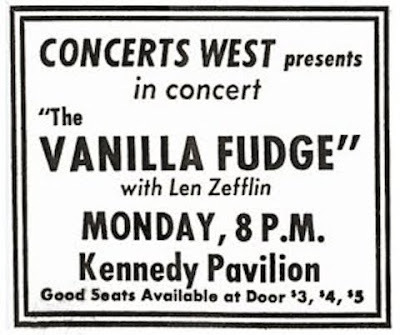 50 years ago today, the band that had been billed as The New Yardbirds in the U.K. played their very first American gig as Led Zeppelin. No recording exists of that performance but fast forward ahead to December and a poor quality reel to reel can be found of the live performance of the band who opened for "The" Vanilla Fudge and who was incorrectly billed as "Len Zeffelin." And you know how it is with opening bands, nobody listening, or planning on it, and then Page, Plant, Bonham, and Jones took the stage. In an instant the crowd was universally mind-blown.The band's first album wouldn't hit stores for another three weeks, but no one had ever heard anything like this. By the time Zeppelin left the stage, it was like psychedelia was dead and heavy metal was born, all within the span of a few hours. Poor The Vanilla Fudge.Here is the playlist:1 - Train Kept A Rollin'
50 years ago today, the band that had been billed as The New Yardbirds in the U.K. played their very first American gig as Led Zeppelin. No recording exists of that performance but fast forward ahead to December and a poor quality reel to reel can be found of the live performance of the band who opened for "The" Vanilla Fudge and who was incorrectly billed as "Len Zeffelin." And you know how it is with opening bands, nobody listening, or planning on it, and then Page, Plant, Bonham, and Jones took the stage. In an instant the crowd was universally mind-blown.The band's first album wouldn't hit stores for another three weeks, but no one had ever heard anything like this. By the time Zeppelin left the stage, it was like psychedelia was dead and heavy metal was born, all within the span of a few hours. Poor The Vanilla Fudge.Here is the playlist:1 - Train Kept A Rollin'2 - I Can't Quit You
3 - As Long As I Have You (incl Fresh Garbage / Shake / Hush)
4 - Dazed And Confused (at over 17 minutes long)
5 - White Summer (27:43)
6 - How Many More Times (incl. The Hunter) (34:31!)
7 - Pat's Delight (50:07!!)
Published on November 09, 2018 15:11
November 8, 2018
Laurel Canyon - 50 Years Ago
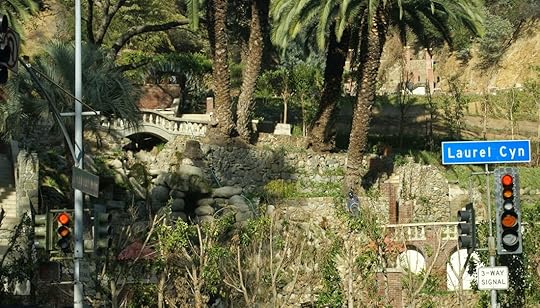 Houdini Mansion - Laurel Cyn. and Lookout Mtn. RoadAsk anyone in America where the craziest people live and they'll tell you California. Ask anyone in California where the craziest people live and they'll say Los Angeles. Ask anyone in Los Angeles where the craziest people live and they'll tell you Hollywood. Ask anyone in Hollywood where the craziest people live and they'll say Laurel Canyon. And ask anyone in Laurel Canyon where the craziest people live and they'll say Lookout Mountain. So I bought a house on Lookout Mountain. —Joni Mitchell
Houdini Mansion - Laurel Cyn. and Lookout Mtn. RoadAsk anyone in America where the craziest people live and they'll tell you California. Ask anyone in California where the craziest people live and they'll say Los Angeles. Ask anyone in Los Angeles where the craziest people live and they'll tell you Hollywood. Ask anyone in Hollywood where the craziest people live and they'll say Laurel Canyon. And ask anyone in Laurel Canyon where the craziest people live and they'll say Lookout Mountain. So I bought a house on Lookout Mountain. —Joni Mitchell50 years ago, Laurel Canyon was a quiet enclave of once grand mansions, homes of stars of the silent age left abandoned or in disrepair; else it was Bohemian flats, the left of center faction who just had to get away. Between the houses were nothing but eucalyptus trees and sagebrush and wild olives. People of money, new money in particular, were all about Beverly Hills or south of the boulevard on the Valley side. Laurel Canyon was quiet and the freeways at either end of Mulholland quelled the traffic. There was but one store (there still is), the canyon was narrow and inaccessible, having little appeal for the literati, the elite, the influx of New Yorkers. Yet rent was cheap and it was close to the city and the studios, and by 1965 the canyon had become a destination (or a point of departure). Within a year it would be a bastion of the soon to be famous, an endless list: Joni and Jim, The Seeds, The Turtles, Mama Cass, Jackson Browne, Peter Tork, Crosby, Stills, Nash and Young, on and on.
A myriad of canyons snake through the Santa Monicas from L.A. into the Valley: Topanga, Sepulveda, Beverly Glen, Benedict, Coldwater and Laurel. I lived in Beverly Glen from 1981 to 1983 in a one room cottage with a huge stone fireplace, the Beverly Glen Mart just up the road, and when I research who lived where, the rock history in those hills, it feels as if I'm a part. Through my father's contribution to music, those billboards along the Sunset Strip, I have a tangible connection, but living among the Eucalyptus and the palms, I was somehow akin to that Laurel Canyon crowd. As a writer, and having just finished memoirs that reflect L.A. in the 60s, 70s and 80s (Jay and the Americans), and with the passing of my father, I feel particularly close to those hills and those people. Putting the era and the canyons into perspective is a great read by Michael Walker titled Laurel Canyon: the Inside Story of Rock-and-Roll's Legendary Neighborhood. I do not have the authority to do so, but reprinted here is an excerpt from from the text (available through Amazon):
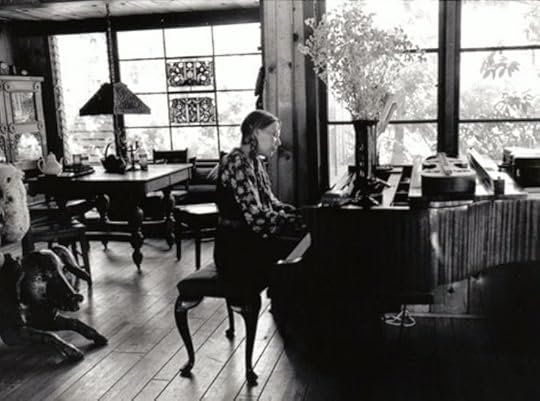 Joni MitchellIn 1968 a British pop star and the refugees from two seminal Los Angeles bands gathered in a cottage on Lookout Mountain Avenue in Laurel Canyon, the slightly seedy, camp-like neighborhood of serpentine one-lane roads, precipitous hills, fragrant eucalyptus trees, and softly crumbling bungalows set down improbably in the middle of Los Angeles, and sang together for the first time. The occupant of the cottage, which had moldering shake shingles and draft-prone casement windows, was a Canadian painter, poet, and folksinger named Joni Mitchell. The British pop star, sporting a wisp of a goatee and a thick Manchester brogue, was Graham Nash, founding member of the Hollies. The refugees were Stephen Stills, late of the Buffalo Springfield, writer and singer of "For What It's Worth," who had three years before auditioned for the Monkees and, having failed, recommended his friend, a folkie named Peter Torkelson; and David Crosby, late of the Byrds and "Mr. Tambourine Man," possessed of a Buffalo Bill mustache, an immaculate harmony voice, and piercing eyes that Mitchell, with typical literary flourish, likened to star sapphires. (Crosby produced Mitchell's debut album, Song to a Seagull.) So it was that Nash, Stills, and Crosby sat in Mitchell's living room on Lookout Mountain, in the heart of Laurel Canyon, in the epicenter of L.A.'s nascent rock music industry, and for the first time, began to sing together.
Joni MitchellIn 1968 a British pop star and the refugees from two seminal Los Angeles bands gathered in a cottage on Lookout Mountain Avenue in Laurel Canyon, the slightly seedy, camp-like neighborhood of serpentine one-lane roads, precipitous hills, fragrant eucalyptus trees, and softly crumbling bungalows set down improbably in the middle of Los Angeles, and sang together for the first time. The occupant of the cottage, which had moldering shake shingles and draft-prone casement windows, was a Canadian painter, poet, and folksinger named Joni Mitchell. The British pop star, sporting a wisp of a goatee and a thick Manchester brogue, was Graham Nash, founding member of the Hollies. The refugees were Stephen Stills, late of the Buffalo Springfield, writer and singer of "For What It's Worth," who had three years before auditioned for the Monkees and, having failed, recommended his friend, a folkie named Peter Torkelson; and David Crosby, late of the Byrds and "Mr. Tambourine Man," possessed of a Buffalo Bill mustache, an immaculate harmony voice, and piercing eyes that Mitchell, with typical literary flourish, likened to star sapphires. (Crosby produced Mitchell's debut album, Song to a Seagull.) So it was that Nash, Stills, and Crosby sat in Mitchell's living room on Lookout Mountain, in the heart of Laurel Canyon, in the epicenter of L.A.'s nascent rock music industry, and for the first time, began to sing together.
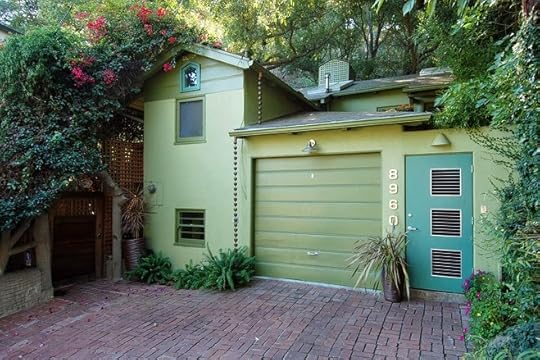 Joni Mitchell's Laurel Canyon HomeIt is a measure of Laurel Canyon's mythmaking powers that this particular watershed may have actually occurred not at Mitchell's cottage — though that's the way Nash and plenty of others remember it — but a mile away in the living room of Cass Elliot of the Mamas and the Papas, who along with Mitchell briefly co-reigned as unofficial queen of the canyon, one an inscrutable poet-genius, the other a bosomy, meddling mother figure. What is certain is that within the year, Nash, Stills, and Crosby apotheosized into Crosby, Stills & Nash, the third group with Laurel Canyon roots within as many years — after the Byrds and Buffalo Springfield — to score a knockout with their first record. Nash moved into Mitchell's cottage on Lookout, there to write his ode to countercultural domestic bliss, "Our House." Mitchell, in turn, wrote and recorded "Ladies of the Canyon," her paean to the strange bohemian netherland where she and Nash nurtured their affair and where it would soon become evident that some of the twentieth century's most talented and enterprising young men and women had gathered at just the right moment.
Joni Mitchell's Laurel Canyon HomeIt is a measure of Laurel Canyon's mythmaking powers that this particular watershed may have actually occurred not at Mitchell's cottage — though that's the way Nash and plenty of others remember it — but a mile away in the living room of Cass Elliot of the Mamas and the Papas, who along with Mitchell briefly co-reigned as unofficial queen of the canyon, one an inscrutable poet-genius, the other a bosomy, meddling mother figure. What is certain is that within the year, Nash, Stills, and Crosby apotheosized into Crosby, Stills & Nash, the third group with Laurel Canyon roots within as many years — after the Byrds and Buffalo Springfield — to score a knockout with their first record. Nash moved into Mitchell's cottage on Lookout, there to write his ode to countercultural domestic bliss, "Our House." Mitchell, in turn, wrote and recorded "Ladies of the Canyon," her paean to the strange bohemian netherland where she and Nash nurtured their affair and where it would soon become evident that some of the twentieth century's most talented and enterprising young men and women had gathered at just the right moment.
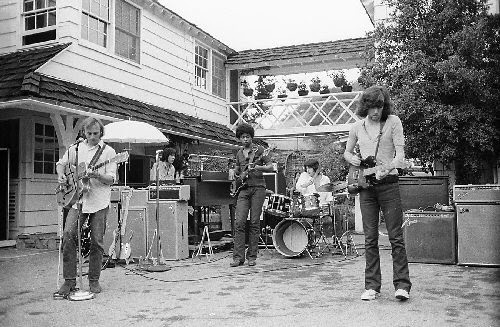 Crosby, Stills, Nash, Greg Reeves and
Crosby, Stills, Nash, Greg Reeves andDallas Taylor Rehearsing for WoodstockLaurel Canyon had been filling up with musicians from Los Angeles, New York, and London since the mid-1960s: Mitchell was a transplant from New York via Saskatoon; Carole King had recently decamped to a place on Appian Way; so had Nico, the Teutonic waif from Andy Warhol's Factory. Up the street from Mitchell's place were John Phillips, Michelle Phillips, and Denny Doherty of the Mamas and the Papas, who, until they moved west and recorded "California Dreamin'" and "Monday, Monday," had busked around as semi-obscure folksingers. British bands touring the States made it a point to stop by Laurel Canyon for a party or two — Beatles, Stones, Animals, Yardbirds, and the rest. Some never left — the British blues legend John Mayall bought a house just over the ridge from Mitchell's place. It was Brigadoon meets the Brill Building, and the repercussions thirty-odd years later continue to pour from radios, iPods, and concert stages around the world.
The Laurel Canyon scene was the reason L.A. earned it's mark on the musical map, and still maintains its hipster folk rock energy today. Emerging local artists come together to experiment, play their hearts out and remind themselves why they're musicians in the first place.
Published on November 08, 2018 06:09
November 6, 2018
Neil Young
While Photographer Henry Diltz captured the spirit and the history of the Canyon music scene, his favorite subject seemingly was Neil Young. Lots of pics of Joni and the Canyon entourage, but I've found more Young photos than anyone else.

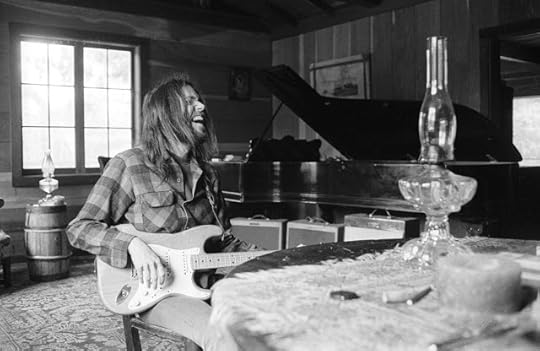
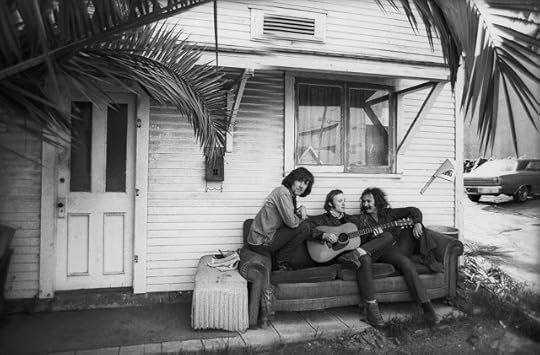


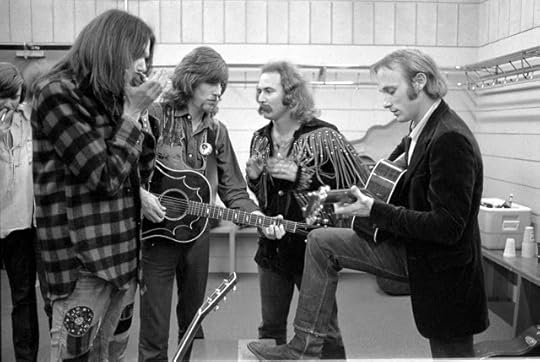










Published on November 06, 2018 03:27
Neil Young - A Bit More Detail
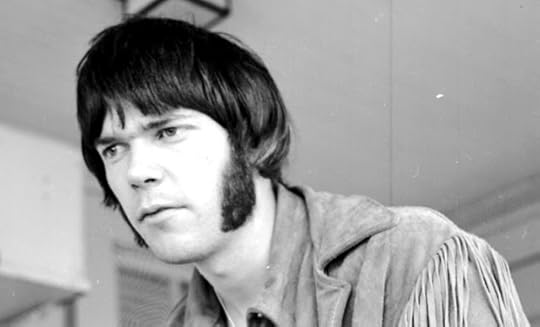 Neil Young was born November 12, 1945 in Toronto. As a youth, he survived diabetes, polio, epilepsy and the divorce of his parents. His father was a highly respected sportswriter for The Toronto Sun and authored several books, including Neil & Me, a 1984 title about his relationship with his musician son. In 1960, Neil moved with his mother to Winnipeg, Manitoba. It was there that music first became the driving force in his life. After switching from ukulele to guitar, he was in a succession of Winnipeg-based bands, including The Jades, The Esquires, The Classics and Neil Young & The Squires.
Neil Young was born November 12, 1945 in Toronto. As a youth, he survived diabetes, polio, epilepsy and the divorce of his parents. His father was a highly respected sportswriter for The Toronto Sun and authored several books, including Neil & Me, a 1984 title about his relationship with his musician son. In 1960, Neil moved with his mother to Winnipeg, Manitoba. It was there that music first became the driving force in his life. After switching from ukulele to guitar, he was in a succession of Winnipeg-based bands, including The Jades, The Esquires, The Classics and Neil Young & The Squires. Initially an instrumental band, a growing trend in pop music with bands like The Ventures, The Squires eventually evolved into a kind of folky rock. Several early Neil originals from the era, including "Ain't It The Truth" and "Find Another Shoulder," would be resurrected years later with the Bluenotes. From early 1963 to mid- 1965, The Squires performed regularly at clubs and dance halls in Manitoba and Ontario. At a club in Fort William, Ontario in '65, The Squires crossed paths with an American folk-rock band called The Company, which featured Stephen Stills. Young and Stills became fast friends, but quickly lost touch.
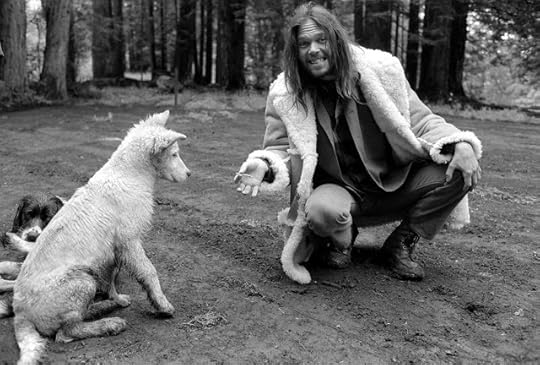
In 1965, Neil recorded an acoustic demo for Elektra Records featuring early versions of "Sugar Mountain" and "Nowadays Clancy Can't Even Sing," but he failed to secure a recording contract. Returning to Toronto, Young played the same Yorkville district coffeehouse circuit as fellow Canadian Joni Mitchell before he joined The Mynah Birds, a Toronto-based band led by singer Ricky James Matthews, probably better known as the Superfreak, Rick James (one of rock's absurdities, like Hendrix opening for The Monkees). James was arrested and charged with deserting the U.S. Navy. The Mynah Birds disbanded when James was forced to complete his tour of duty.
Young and Mynah Birds bassist Bruce Palmer packed their worldly possessions into Young's old black hearse and drove from Toronto to Los Angeles. On the Sunset Strip, the hearse was spotted in traffic by Stills and singer/guitarist Richie Furay. The four musicians huddled in a supermarket parking lot and immediately talked of forming a band. With the addition of drummer Dewey Martin, the Buffalo Springfield was born. Fusing folk and rock with dashes of country and R&B, the Springfield gained immediate recognition, often sharing the bill with The Byrds at The Whisky-A-G0-Go.
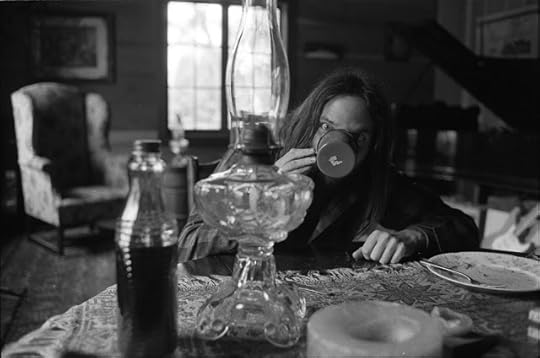
Neil quit Buffalo Springfield in the spring of '67, before the band's appearance at The Monterey Pop Festival in June, then re-joined later that year. The band broke up for good in May 1968. With no small amount of original material to work with, Young, now living in Topanga Canyon, launched his solo career . His self-titled debut was released on Reprise Records in January of 1969, and featured such songs as "The Loner" and "The Last Trip to Tulsa." He would later refer to Neil Young as "overdub city." Indeed, most of his recorded work to follow would bear little resemblance to the layered process used on much of the debut. Early in '69, Young was re-acquainted with a rough-hewn Los Angeles-based band he'd first encountered during the early days of the Buffalo Springfield, The Rockets, who featured guitarist/vocalist Danny Whitten, bassist Billy Talbot and drummer Ralph Molina. In a matter of weeks, Young and these musicians would record "Down By the River" and then, as Neil Young & Crazy Horse, would go on to quickly record classic tracks like "Cinnamon Girl" and "Cowgirl In The Sand," for the album Everybody Knows This Is Nowhere, which was released in July 1969. From there Neil's solo career would take a bit of a hiatus with his joining Stills, David Crosby and Graham Nash. The band's first real gig was one of the features of Woodstock. While generally lackluster, the performances at Woodstock (even that of Hendrix), particularly in comparison to Monterey, were overshadowed by CSN&Y, Joe Cocker and Santana.
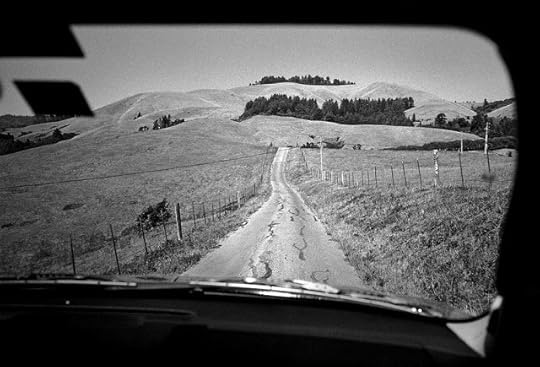
Sometime just before or following Woodstock, Graham Nash visited Neil at Neil's Ranch in Northern California. As the story goes, Neil asked Graham if he wanted to hear something. Nash, of course, said yes and suggested going into Young's studio, but that wasn't the plan. "[Neil] said, 'Get into the rowboat,'" Nash explained on NPR's Fresh Air in 2013. "I said, 'Get into the rowboat?' He said, 'Yeah, we're going to go out into the middle of the lake.'" Nash assumed that Neil had a tape recording on the rowboat. "Oh, no," he said. "He has his entire house as the left speaker and his entire barn as the right speaker. And I heard Harvest coming out of these two incredibly large loud speakers louder than hell. It was unbelievable. Elliot Mazer, who produced Neil, produced Harvest, came down to the shore of the lake and he shouted out to Neil, 'How was that, Neil?'
"I swear to God," Graham said, "Neil Young shouted back, 'More barn!'"
Published on November 06, 2018 03:27



